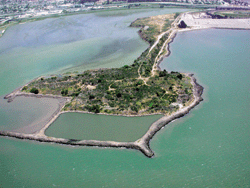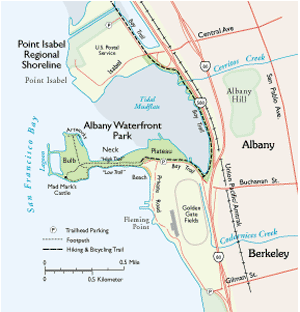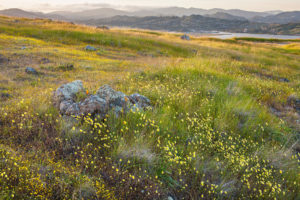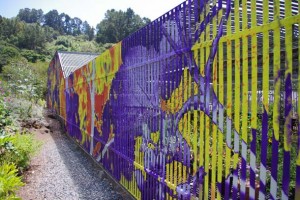I admit that the first time I went to Albany Waterfront Park, I was under the influence of love. It was my first official date with the man I eventually married. He took me to “the Bulb,” as it’s called, to walk his dog. It was probably a test to see if we were compatible. If I liked it, there would be a second date; if not, we’d chalk up our meeting to chance but not destiny. He told me that the Bulb was a former dump (lovely, I thought) and that “you either love or hate this place.” Some people see it as an example of nature overcoming the worst we can do to it; others just see a post-Armageddon scene from The Road Warrior. Maybe it is some of both.
My first impression on that warm July evening in 1999 was one of rough, urban edginess, tamed and softened by the brilliant and unpredictable forces of nature and the equally brilliant and unpredictable outpourings of human creativity. By the time we reached the sculptures and paintings on the north side of the Bulb, I had thoroughly fallen in love.
It’s true that you could look at Albany Waterfront Park as only an abandoned city dump. It is a spit of artificial land made up of decades’ worth of garbage and fill that juts unnaturally into the Bay. With the twisted rebar erupting from the soil and the intertidal mudflats, the substrate of concrete blocks that once fortified freeways and buildings, the chaotic garden of native and nonnative plants, and the remnants of an elaborate homeless colony built from the remains of the landfill and washed-up artifacts from the Bay, this is not a purist’s paradise. But to describe it only as a “dump” is to miss its spirit and sublime beauty. The Bulb is a place to stretch your senses, cross boundaries, and have an adventure; a place full of contradictory images, small discoveries, and delightful, uneasy surprises. It is also at the center of a heated debate about the future Eastshore State Park, of which the Bulb will be a part. Should this former dump become a nature preserve, be remade into a recreational site, or be allowed to remain an outdoor art gallery?
- The Albany Bulb, Plateau (upper center), beach (upper right), andmudflats (upper left) will all be part of the new Eastshore State Park.Photo by Saul Chaikin.
When you first arrive at the Albany Bulb, you have the sense of being on the edge between the urban and the wild—you can feel the strange embrace of the two, as they tug at one another. The Albany waterfront tells the story of nature dominated, tamed, and trashed, but ultimately delivered back to itself. Created as a result of the thoughtlessness of past Albany city officials and the Santa Fe Railroad Company, the Bulb is a testament to nature’s resilient and evolving possibilities.
The history of the Bulb dates to the 1890s, when Santa Fe, under the guise of the Berkeley Waterfront Company, bought up large portions of the Albany, Berkeley, and Emeryville shorelines. These lands remained largely undeveloped until the Golden Gate Turf Club built a racetrack on land leased from Santa Fe; Golden Gate Fields opened in 1947. By the mid-1950s, approximately 2,000 acres of fill had been dumped along the shore. The odd bulb-shaped landfill jutting into the Bay arose from a contract signed in 1963 by the city of Albany and Santa Fe for disposal of debris from construction and freeway projects. Citizen opposition to the dumping began almost immediately and continued through the 1980s. The dumping finally ended in 1987 as a result of lawsuits against the landfill operator and a successful campaign to include the newly created land and shoreline in the proposed Eastshore State Park.
You’ll find the park just west of the junction of I-80 and I-580, north of Golden Gate Fields. To the left of the parking lot is one of the few shoreline beaches available to East Bay residents; there are spectacular views from here of the Bay, San Francisco, the Golden Gate and Bay bridges, and Mount Tamalpais.
Just to the northwest of the beach, you’ll find the trail that leads out along the “neck” of the Bulb following the shore, which my son calls “the low road.” Here one finds the first signs of the guerrilla art created by the collective group of artists called SNIFF, five men who have turned the Bulb into an open-air gallery. They have been at work for the past four years, creating sculptures, installations, and three-dimensional canvases from the remains of the former dump and from objects that have washed up from the Bay.
Up above this shoreline trail, on “the high road,” is an upland plateau (not to be confused with “the Plateau,” the easternmost section of the park). The unmarked, meandering paths here cut through fennel and coyote brush, and when you head south toward the bayside to join a trail that circles the Bulb, you see complexity and odd jux-taposition everywhere. The roadcut alongside the trail exposes not layers of sedimentary rock, but rather layers of huge, broken concrete blocks, car parts, and tangles of twisted rebar, all set off by flowers in bloom.
It’s hard not to notice the profusion of nonnative plants. Plant life does include natives such as coyote brush, ceanothus, poison oak, and California poppy, but these are accompanied by nonnatives such as fennel, acacia, euphorbia, valerian, sour grass, Scotch broom, pampas grass, and palm trees. On a recent trip, I even discovered a loquat tree loaded with green, unripe fruit. This is not the place for a native plant purist, but the juxtaposition of these natives and nonnatives has created a fascinating laboratory for understanding a facet of succession and natural selection that is responsible for some unusual habitat formation. The hillsides of the Bulb, for example, are host to a colorful display of pink, white, and red valerian, a Mediterranean species that flourishes in disturbed areas such as the ruins of Greece. Here it attracts various insects, butterflies, and hummingbirds as it grows in between concrete slabs, rebar, and scrap metal. Because the Bulb was also a dump for garden refuse in the 1980s, you can now find all kinds of backyard plants thriving without a gardener’s hand: a patch of domesticated yellow irises in bloom, a rosebush gently proclaiming itself, or a creeping patch of orange-blossomed nasturtiums. Near the plateau, someone has built a superbly crafted hut from bundles of fennel branches (in the style of a Miwok willow structure), complete with a fire pit and smoke hole.

- A massive archway made out of the washed-up Styrofoam pontoons of afloating dock frames distant Mount Tamalpais. Photo by Scott Braley.
From the upland, you can follow the rambling trail that circles the shore from the south. There are remnants of chimneys, a huge iron box (what would one do with an iron box this big?), and more rebar and concrete. In the intertidal zone, the concrete shimmers with a coat of brilliant green algae and the rebar is thickened by layer upon layer of acorn barnacles. Two years ago, a juvenile gray whale washed up here, leaving its gelatinous mass and stench for several weeks.
Just past this part of the shoreline are concrete steps leading up the hillside to Mad Mark’s Castle, a fantastic blue-and-white structure built by one of the Bulb’s eccentric and creative former residents. The entire structure is made from salvaged concrete and has one of the best views of the Golden Gate on the Bulb. Mark claims that when the colony of residents was evicted from the Bulb in 1999 and all their structures were destroyed, he saved his castle by convincing officials that it was a work of art, not a shelter.
The unmarked trail, impassable at high tide, continues along the shore until you encounter a small lagoon. It is part of the unfinished landfill: a levee was built to trap water and then construction debris would have been placed inside the lagoon. Instead of debris, this unnatural lagoon is now visited by a variety of shorebirds and waterfowl, including geese, ducks, coots, oystercatchers, willets, black turnstones, sandpipers, great blue herons, and gulls. For a seven-year-old, this is also the best spot in the entire Bay Area for skipping rocks.
At low tide, circling around the lagoon on the narrow rock path is no problem, but during high tide, you’ll have to head back up the hillside, where another trail meanders through thick fennel forests to rejoin the north side of the Bulb. On this hillside, amidst the various paths, you’ll find a strange platform of concrete and wood, obviously one of the favorite spots of the folks who used to live here. Before the eviction, one of the residents explained to me, “We’re not homeless; we live here. When they kick us out, then we’ll be homeless.”
After making your way around the westernmost point of the Bulb (either by circling the lagoon or by way of the hillside), you reach a small cove where two shipwrecked, lopsided boats lie hauntingly broken and decaying in the shallow, muddy water. Mark says he lived in one of these boats until an “authority” shot a hole in it and sank it. Around the cove and across the stretch of a long, rocky beach, you arrive at the northernmost part of the Bulb facing the Richmond post office facility and Costco. This is the central “exhibit hall” for the public artwork of the SNIFF collective, the place where many visitors come each week to discover what has taken shape in the merging of artistic inspiration and the debris washed up on the beach or left in the landfill.
One of the oldest, most ambitious pieces is a 25-foot-long ship built from driftwood and construction planks. For several years, a painted sign next to the good ship SNIFF warned, “A curse upon any hand or foot that does harm to this boat.” Flying high on a mast is the SNIFF flag, which has become the trademark symbol by which you recognize the collective’s hand. Other pieces include a “Just Married” couple made of driftwood; huge heads skillfully painted to capture the features and expressions found in the natural contours of rocks and concrete blocks; a sea god made from metal scraps, wood, and wire; a large cement box painted from top to bottom with free-floating naked human forms that I call the “Naughty Sistine Chapel”; and a massive archway made out of the washed-up Styrofoam from the pontoons of a floating dock.
While some people don’t appreciate the themes and subjects of the artwork (it tends toward the fantastic and the sexually explicit, somewhere between Gabriel García Márquez and Robert Mapplethorpe), it is difficult not to be awed by the humor and creativity that has turned a garbage dump into a space for viewing art that is urban, unmediated, and spontaneous. Osha Neumann, the most recent member of the SNIFF collective, calls the Bulb “a place of exceptional imagination . . . it maintains itself. It is a uniquely successful experiment in biological and cultural diversity. Nature reclaimed the rubble; she did it her way.” In its unexpectedness and its wildness, in its generosity and its anarchy, the work of Neumann, Scott Hewitt, Bruce Rayburn, David Ryan, and Scott Meadows successfully mimics the larger processes at work on the Bulb.
After you leave the gallery, you can take a trail back up toward the neck of the park, or you can continue to wind your way around the northeast side of the Bulb. This is known as “the Marsh,” and it hosts a wide variety of migratory shorebirds. Jeff Haltiner, a hydrologist working on wetlands planning for the Eastshore State Park, says the landfill in Albany has actually generated some interesting wetlands habitat: “The landfill provides additional silt accumulation, more wetland vegetation along the shoreline, and has created a more quiescent setting for shorebirds.” Ninety percent of the Bay Area’s wetlands have been destroyed by development, driven by the same mindset that led to the creation of the Bulb. Yet here human recklessness has wrought a contradictory result: protected mudflats that are a serendipitous habitat addition, a refuge for black-necked stilts, avocets, western sandpipers, and other migratory shorebirds during the winter months. Some land birds not usually associated with urban landscapes can also be found regularly on the Bulb, including burrowing owls, northern harriers, and white-tailed kites. In addition, the nearby Plateau provides habitat for western meadow-larks and savannah sparrows.

- A rainbow behind Albany Hill echoes the colorful plants found along the bluffs at the Bulb. Photo by Scott Braley.
All that has enchanted me about Albany Waterfront Park may now be on the verge of disappearing, or at least of being transformed into something different, something controlled and engineered to provide a much more conventional “park experience.” Last week, I sat quietly atop Mad Mark’s Castle and took in the breathtakingly clear view of the City from an abandoned orange arm-chair on the roof. My son and I found several buckets and began a spontaneous chant and drumming session amidst the rubble and ruin. Toward the end of our hike, we encountered the SNIFF collective working by the mudflats on several large wooden canvases in an elaborate and colorful scene of human chaos and play. Surrounding the artists was an entourage of admirers, friends, children, and free-running dogs, all taking in the sunshine and beauty of the surroundings while watching the unfolding creation. Where else could this happen?
The prospect of turning this freewheeling place into a state park raises inevitable questions. What will it mean to the spirit of the Bulb to impose rules, establish formal trails, and post signs? Will its transformation necessarily involve uprooting nonnative plants, carting away the public art, and removing the concrete and rebar? The apparently arbitrary paths, the imaginative creations, and the sheer variety of things to look at are the surprises and adventures that make this place unique and that bring us back time and again. Are we tolerant enough to expand our definition of parkland to include this kind of anarchic relationship between nature and human creativity? Are we brave enough to allow for—and welcome—the unpredictable on a large scale? My son certainly hopes so.
The Eastshore State Park and the Fate of the Albany Bulb
The new Eastshore State Park comprises one of the largest undeveloped public landholdings fronting San Francisco Bay, stretching from the Bay Bridge in Oakland to Marina Bay in Richmond. The 8.5-mile-long, 260-acre park is the result of more than four decades of lobbying, negotiations, and ballot initiatives by local environmental activists. In 2000, the Department of State Parks, in conjunction with the East Bay Regional Park District, began the planning process for the new park.
Following regional workshops held to solicit comments from the public, the first general plan for the park was presented in March 2002. The plan attempts to reconcile the views of the two most vocal constituencies: recreation advocates and environmentalists. Soccer clubs, Little League groups, and other sports enthusiasts see the new park as an opportunity to address the shortage of playing fields in the East Bay. Other advocates for “active” recreational uses include kayakers, windsurfers, and fishermen, who want greater access to the shoreline and water. Of necessity, this entails the construction of parking and launching facilities.
The environmental groups that campaigned long and hard to make Eastshore Park a reality—Save the Bay, Citizens for the Eastshore State Park, Sierra Club, Golden Gate Audubon, and others—take a different view. “The idea of putting ball fields in one of the most environmentally sensitive areas of the East Bay seems ludicrous,” says Norman La Force, the author of Creating the Eastshore State Park: An Activist History. For environmentalists, the park is an opportunity to counter the effects of decades of filling the Bay and destroying wetlands, and for urban residents to observe and interact with a bayshore wildlife habitat that has disappeared from so much of the rest of the Bay. Arthur Feinstein, co-executive director of the Golden Gate Audubon Society, sees the Eastshore State Park as a “major opportunity to give our children a better understanding of our natural world.”
In the official plan, areas designated for habitat preservation include the Emeryville Crescent, the Albany Mudflats, and the South Richmond Shoreline/Hoffman Marsh. Other areas with established yet less pristine habitat, such as the Berkeley Meadow and the Albany Bulb, would be protected as open space with some “enhancement.” At the Albany Bulb this would include removal of artwork and nonnative plants, and banning of off-leash dogs. Still other areas, including the Albany Plateau, would be turned into facilities for active recreation, such as ball fields and boat launches. A group calling itself Albany/Let It Be has come together recently to oppose these measures for the Bulb in particular. They like the Bulb as it is, maintaining that artists, hikers, birders, and dog walkers coexist now, and enjoy the opportunity to have unmediated experiences.
East Bay residents can comment on the general plan by attending the regional planning workshops scheduled for October 2002, sponsored by the state and the East Bay Regional Park District. If you would like more information or want to get involved, contact the following organizations:
East Bay Regional Park District: http://www.ebparks.org/parks/eastshore
Albany/Let It Be: (510) 845-4809, www.albanyletitbe.com
Citizens for the Eastshore State Park: Sara Stern, (510) 848-0800, ext. 313
Golden Gate Audubon Society: (510) 843-2222
Sierra Club, SF Bay Chapter: Norman La Force, (510) 526-4362, nlaforce@ix.netcom.com
Getting There:
Albany Waterfront Park is at the west end of Buchanan Street. From i-80 east, take the Buchanan St. exit and turn left under the freeway overpass. From i-580 east, take the Albany exit and turn right under the overpass. There is no convenient public transit access.

.jpg)





